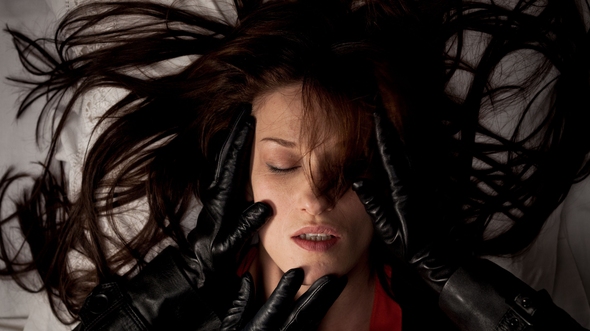Defining Jonathan Glazer's Under the Skin as an alien invasion film wouldn't even begin to describe one of the most interesting cinematic excursions of the year - just as his previous films Sexy Beast (2000) and Birth (2004) challenged the limitations of their specific genres (crime thriller and paranormal drama respectively), his latest work intelligently defies a viewer's expectations.
Image courtesy of Film 4
Under the Skin is based on a novel by Michel Faber; whilst Glazer remains faithful to the book's central idea (an alien arrives on earth looking for human prey), he reduces the narrative to a very basic, almost skeletal concept, abandoning most dialogue, and offering very little explanation for what happens on screen. Suitably, the film opens with a mysterious sequence that echoes Kubrick's 2001: A Space Odyssey: a series of close-ups of a variety of abstract, circular shapes (perhaps signifying the rebirth of the alien, her mutation into human form) accompanied an eerie musical piece. The mood swiftly changes as we are transported to contemporary Glasgow, where our unnamed protagonist drives around in a white transit van, occasionally stopping young men to ask for directions or to offer them a lift. The alien is played by Scarlett Johansson, barely recognisable in a black wig and cheap fur coat. The effect of combining an A-list Hollywood star that is largely associated with glamorous hyper-sexuality with a context that seems so at odds with her persona is nothing short of exhilarating. If the director was trying to tell us something about feeling alienated by a certain environment (the film arguably follows the protagonist's perspective), he is certainly successful in his aim. Glasgow is filmed in a a naturalistic manner that borders on cinema-vérité (part of the film was shot with hidden cameras) - real situations, real people, real shop fronts, real streets, real accents. This milieu is contrasted with Johansson's well-spoken, physically attractive persona - she is not only an alien (in both a tangible and metaphorical sense) roaming the streets of a busy city much like Robert De Niro's Travis Bickle did in Taxi Driver (1975), but also a fiercely alluring star from a world so far removed from the West of Scotland.
The alien's aggressive and unsympathetic attitude changes in the latter part of the film when she suddenly abandons Glasgow for the majestic but stark Scottish countryside. Here, surrounded by a thick mist that becomes a signifier for her sense of isolation, she morphs into a vulnerable, confused figure that becomes the victim instead of the aggressor. Interestingly, she also starts coming to terms with her human body (an emblematic sequence involves Johansson curiously observing her naked body at the mirror): is her new frailty inseparable from the human form she finally feels aligned to? Or is the violence she is subjected to a comment on her 'woman as a sex object' status? Jonathan Glazer has stated that he did not intend to tackle gender issues with Under the Skin, but there are discernible feminist undertones in the way his protagonist's body becomes a central subject (maybe even the central subject) of the film.
Under the Skin is never impenetrable, but its esoteric nature, its 'openness' and its clever mix of different cinematic elements mean that multiple interpretations become possible. Scarlett Johansson's alien takes on a journey that partly resembles a poignant coming of age tale, even though her desire to fit in never materialises. Jonathan Glazer leaves his mark all over this strange fable: his vision is capable of polarising audiences, but it also capable to provide a distinctive film experience that knows how to reward a viewer that can approach it with an open attitude.
Erika Sella



























